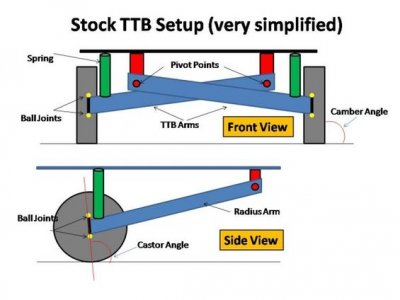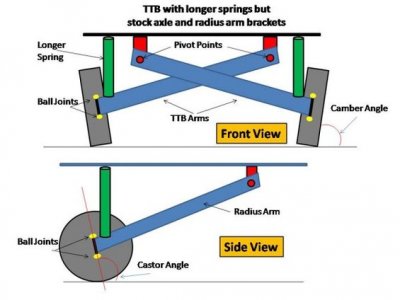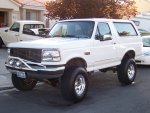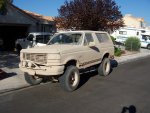Roadkill
New member
A common question when lifting TTB (Twin Traction Beam) suspensions is, "Why do I need drop brackets?" or "Why can't I just add a coil spacer or use longer springs?" Actually you can do that, but you will have alignment problems if you lift more than an inch or two. The alignment problems can cause excessive tire wear and steering problems. With this post, I will attempt to explain why.
There are three factors to alignment, Castor, Camber, Toe-in/Toe-out. In this post, I will only be talking about Castor/Camber and how they are affected by lifting the TTB suspension. I made this picture to illustrate the relationships of the TTB components and how Castor and Camber angles are measured.

Steering is accomplished by pivoting the wheels right or left on the axis between the upper and lower ball joints. The only method to adjust Castor/Camber angles on the stock TTB is by changing the bushing/spacer that the upper ball joint is mounted in. This will move the top of the wheel in and out or forward and rearward a small amount to obtain the optimum Castor/Camber angles. There is only room for about 1/2 inch adjustment any direction from dead center. (Only amounts to about 2 degrees of adjustment)

The picture above, is exaggerated, but it illustrates the affect of using longer springs or spacers to lower the wheel without lowering the axle and radius arm pivot points the same amount. If you are only lifting a small amount, (1 or 2 inches) you should be able to change bushings on the upper ball joints to bring things back into alignment. Adjustable bushings are also available. They eliminate the need to replace bushings during alignment, but they won't give you any increase in the amount of adjustment possible. If you are adding larger lift amounts, (4
There are three factors to alignment, Castor, Camber, Toe-in/Toe-out. In this post, I will only be talking about Castor/Camber and how they are affected by lifting the TTB suspension. I made this picture to illustrate the relationships of the TTB components and how Castor and Camber angles are measured.

Steering is accomplished by pivoting the wheels right or left on the axis between the upper and lower ball joints. The only method to adjust Castor/Camber angles on the stock TTB is by changing the bushing/spacer that the upper ball joint is mounted in. This will move the top of the wheel in and out or forward and rearward a small amount to obtain the optimum Castor/Camber angles. There is only room for about 1/2 inch adjustment any direction from dead center. (Only amounts to about 2 degrees of adjustment)

The picture above, is exaggerated, but it illustrates the affect of using longer springs or spacers to lower the wheel without lowering the axle and radius arm pivot points the same amount. If you are only lifting a small amount, (1 or 2 inches) you should be able to change bushings on the upper ball joints to bring things back into alignment. Adjustable bushings are also available. They eliminate the need to replace bushings during alignment, but they won't give you any increase in the amount of adjustment possible. If you are adding larger lift amounts, (4
Last edited by a moderator:



